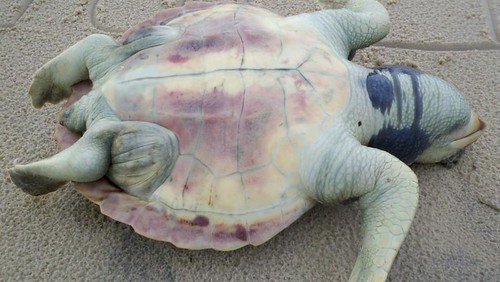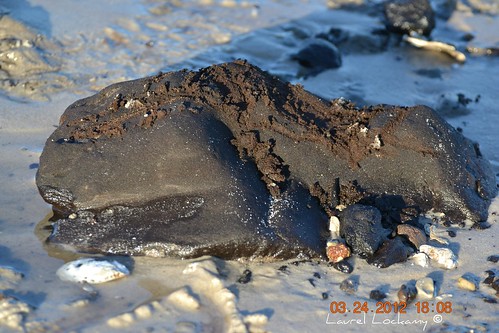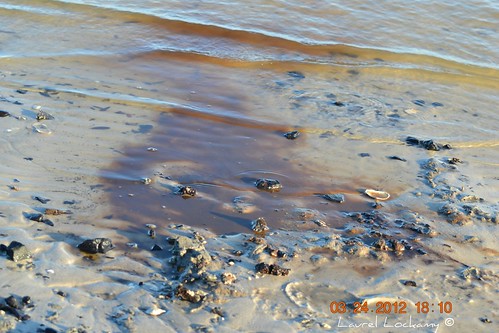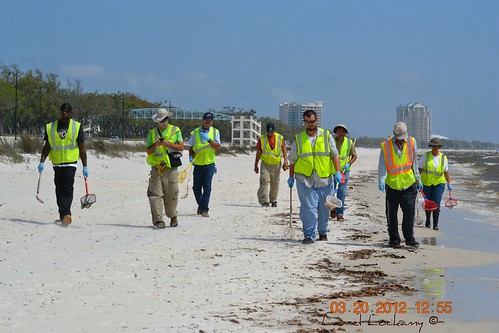Mississippi Residents Find Death Along Oily Gulf Shores

Dead dolphin on Mississippi Beach in 2011 Photo: Laurel Lockamy
Since BP’s catastrophic oil blowout nearly two years ago, Laurel Lockamy has gotten pretty good at photographing the dead. She’s snapped images of dozens of lifeless turtles and dolphins, countless dead fish, birds, armadillos and nutria and pretty much anything that crawls, swims or flies near the white sandy Mississippi beaches of her Gulfport home.
Locals say this is far from normal. Laurel's pictures can be hard to believe; photos of large bottlenose dolphins, their mouths agape and their silvery bodies stretched out like aluminum mannequins on the tar ball-littered sand as children frolic nearby in the warm waters of the Gulf. She's taken shots of rotten, decaying endangered sea turtles wasting away on the shores, sprayed with orange paint by marine mammal experts for disposal by beach cleanup crews who sometimes take days to respond.
Last week was no different for Laurel, who was out taking pictures of sea life with her new Nikon lens. A strong spring storm had roiled the brown Gulf waters, apparently stirring up globs of the 200 million gallons of Louisiana crude that BP’s well spewed into the Gulf in 2010. Laurel says she found tar balls the size of bricks in the sand, spit out by the violent sea.
Not far away, Charles Taylor was walking along the beach on his birthday and found four dead endangered Kemp Ridley sea turtles washed up in Waveland. They were just a few of the 40 or so decaying sea turtles that have rolled in with the Gulf waves in recent weeks, making a resurgent appearance after spiking in unusual numbers a year ago. Here’s what a National Oceanographic and Atmospheric Administration official told Mississippi Public Broadcasting this week:
"These numbers seem to be comparable to what we saw last year. NOAA scientists are always concerned when we see sea turtles strand. So what we’re doing is we’re collecting the sea turtles and we’ll necropsy as many of those as we can to see if we can determine what has caused these strandings."

Dead turtle in Waveland, MS, March 22, 2012 Photo: Charles Taylor
Laurel didn’t find dead turtles on a recent stroll on her Gulfport shores, which she now calls "death beach." But walking along she smelled something bad. After poking around in the sand, she found the nauseating source; a dead baby dolphin’s tail, decomposing and buried not more than a few inches in the sand. An out-of-work shrimper came a long and picked it up, and when he realized what it was he started to sob; "This really ruins my day..." Laurel remembers. Tourists looked at it incredulously, Laurel says, their kids screaming, 'Mommy, it's a dolphin's tail!'
“It’s surreal what we find out here now," Laurel says "Sometimes I think this can’t be happening. It’s gotten to the point where I just don’t want to look down at the beach anymore.”

Mississippi resident with dolphin tail; photo by Laurel Lockamy
As the second anniversary of the worst offshore oil spill in history approaches, the signs are not good things will return to normal anytime soon. Fishermen continue to complain that healthy shrimp, oysters and crab are hard to find, and some of the ones they're finding are loaded with lesions and abnormalities. Dolphins still die in record numbers; a recent report from scientists studying dolphins in Louisiana’s oil-soaked Barataria Bay found severe illness in a group of dolphins they are closely monitoring.
Based on comprehensive physicals of 32 live dolphins from Barataria Bay in the summer of 2011, preliminary results show that many of the dolphins in the study are underweight, anemic, have low blood sugar and/or some symptoms of liver and lung disease. Nearly half also have abnormally low levels of the hormones that help with stress response, metabolism and immune function. Researchers fear that some of the study dolphins are in such poor health that they will not survive. One of these dolphins was found dead in January 2012.
A few days before Laurel found the dolphin tail, just after the storm had blown in from the Gulf, she was out photographing tar balls and dead sea life that had washed ashore. Some of them were more like tar logs, the size of large shoes, she says, globs of hardened petroleum that oozed brown sticky oil when squeezed. Laurel says when she squashed them near the water's edge the water turned oily and brown.



Tar balls and cleanup crews near Gulfport, MS Photos: Laurel Lockamy
Laurel says she ran into a woman who refused to believe the tar balls were oil, but after squeezing them and getting oil all over her hand, the woman demanded a picture to document it. “Take my picture, people need to see this,” Laurel recalls her saying, before she rushed off to find some strong detergent to wipe the sticky petroleum substance clean.
She was wise to look for a quick way to wash off. New research from the University of Auburn shows tar balls from the BP oil blowout may not be as innocuous as some think. Here’s how The Birmingham News reported it:
They found that the tar balls -- which oil executives and government officials have said are little more than a nuisance -- are teeming with bacteria, including Vibrio vulnificus, the leading cause of death from eating bad oysters. In fact, they discovered that the balls had up to 100 times more of that particular bacteria than the water they floated in and 10 times more than the sand they rested on.
“People don’t know what’s going on down here,” Laurel says. “The oil is still here and things are still dying. BP likes to make all their pretty commercials about how everything’s fine. Well I’m still here too and it’s not. But I'm going to keep doing what I'm doing to show people what's really going on here.”
Laurel isn’t the only one. An interesting thing happened after the historic BP oil blowout: hard-working people living in the shadows of Big Oil grew tired of the status quo. They are demanding accountability from their political leaders and from the industries and powerbrokers who call the shots. They are a small but dedicated corps of Gulf residents who constantly monitor their beaches and shorelines, photographing and documenting the steady stream of death and oily waste that still washes in.
No one knows what the final toll of the BP debacle will be. But lovers of the Gulf continue to patrol their shores, alerting people to a disaster that seems to have no end.
